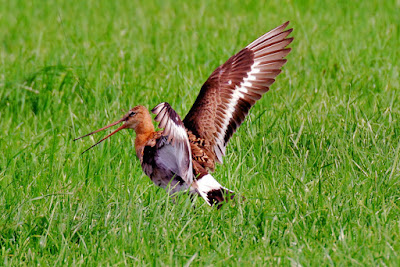The still northerly breeze meant no ringing but the early morning sun dictated a birding trip to the customary hot-spots, starting at Conder Green.
On Saturday four Avocets fed together but today it was back to perhaps an earlier pair, probably the two that arrived a couple of weeks ago. Following a good few days of sunnier if not necessarily warm weather the female is now sat on a nest.
Meanwhile the two second year Avocets that spent a few hours here on Saturday morning seemed to have gone and were merely passing through on their way north and/or east. Avocets don’t normally breed until their third year whereby second year birds make up the numbers in the colonies that Avocets sometimes, but not always choose to breed. Conder Green is large enough for several pairs of Avocets but that is not necessarily a good thing as the species can be very aggressive in seeing off all opposition, large or small.
There was no such aggression today, mainly because there was little for the Avocets to complain about.
The usual water birds comprised 2 Greenshank, 1 Common Sandpiper, 6 Tufted Duck, 8 Teal, 16 Shelduck and 2 Little Egret. A Kingfisher put in another brief appearance by flying through the creek, up and over the road, and then across the pool and out of sight.
Passerines were hard to come by except for singles of Blackcap, Whitethroat, Willow Warbler, Reed Bunting and Meadow Pipit in the scrubby habitat next to the main road. I’m seeing only male Whitethroats just yet but not in great numbers. The continual north winds, blocking high pressure and below average temperatures must be holding many migrant birds back on the south coast or beyond.
Whitethroat
26th April
Meadow Pipit
As I drove off from Conder Green a Kestrel hovered over the marsh and for a few seconds pulled in a couple of complaining Swallows. I didn’t see too many Swallows during the morning, just one or two House Martins, and I didn’t stop to survey the Sand Martins at Bank Lane.
The marsh at the end of Bank Lane was very quiet, the best I could muster being singles of Whimbrel and Grey Heron, and then 6 Pied Wagtail.
Whimbrel
I spent quite a while along Jeremy Lane, Moss Lane and up to Cockersands. I had Wheatear, Chiffchaff, Reed Bunting, Linnet, Goldfinch, 3 Sedge Warblers and 3 Whitethroat. Just as feared, a number of fields that held Lapwings and Skylarks have been ploughed just as ground nesting birds have eggs and/or tiny young. I found a pair of Skylark in one regular spot but at another unvarying spot of the last few weeks - nothing. A good few fields had been ploughed right up to the fence line and the 80/100 Lapwings of recent weeks seem well down, replaced today by 8 Stock Doves attracted by the turned soil.
Skylark
Lapwing
Near Lighthouse Cottage a male Whitethroat was in full song and showy mood for the females yet to arrive. His singing and display circuit proved easy to suss: the overhead wire and then the tallest bushes of the roadside plot, followed by a scurry along the roadside fence where sprigs of bramble provided cover. A singing Sedge Warbler stuck to the vegetation and wasn’t as obliging as the Whitethroat.
An adult male Whitethroat has a lovely pink wash across the breast upon first arrival in late April but the healthy glow soon vanishes during the rough and tumble of a British summer.
Whitethroat
Whitethroat
Sedge Warbler
Whitethroat
I may be out on Friday if the weather holds good. Log in then for more news, views and photos.
Linking today to
Eileen's Saturday.



































































.JPG)






.jpg)











